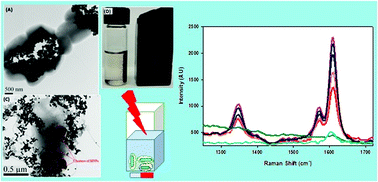Magnetic-optical nanohybrids for targeted detection, separation, and photothermal ablation of drug-resistant pathogens†
Abstract
A rapid, sensitive and quantitative immunoassay for the targeted detection and decontamination of E. coli based on Fe3O4 magnetic nanoparticles (MNPs) and plasmonic popcorn-shaped gold nanostructure attached single-walled carbon nanotubes (AuNP@SWCNT) is presented. The MNPs were synthesized as the support for a monoclonal antibody (mAb@MNP). E. coli (49979) was captured and rapidly preconcentrated from the sample with the mAb@MNP, followed by binding with Raman-tagged concanavalin A-AuNP@SWCNTs (Con A-AuNP@SWCNTs) as detector nanoprobes. A Raman tag 5,5′-dithiobis-(2-nitrobenzoic acid) (DTNB) generated a Raman signal upon 670 nm laser excitation enabling the detection and quantification of E. coli concentration with a limit of detection of 102 CFU mL−1 and a linear logarithmic response range of 1.0 × 102 to 1.0 × 107 CFU mL−1. The mAb@MNP could remove more than 98% of E. coli (initial concentration of 1.3 × 104 CFU mL−1) from water. The potential of the immunoassay to detect E. coli bacteria in real water samples was investigated and the results were compared with the experimental results from the classical count method. There was no statistically significant difference between the two methods (p > 0.05). Furthermore, the MNP/AuNP@SWCNT hybrid system exhibits an enhanced photothermal killing effect. The sandwich-like immunoassay possesses potential for rapid bioanalysis and the simultaneous biosensing of multiple pathogenic agents.


 Please wait while we load your content...
Please wait while we load your content...